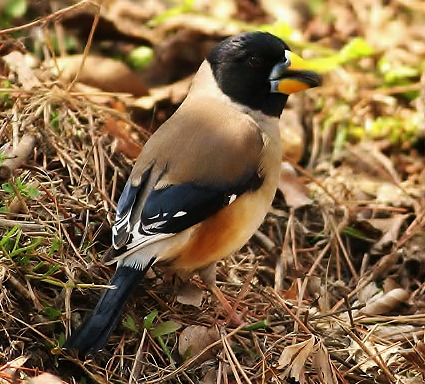 |
| Photo by Tim Edelsten (Birds Korea) |
Common name:
yellow-billed grosbeak (en); bico-grossudo-chinês (pt); gros-bec migrateur (fr); pepitero de cola negra (es); weißhand-Kernbeißer (de)
Taxonomy:
Order Passeriformes
Family Fringillidae
Range:
These birds breed in south-eastern Russia, Korea, Mongolia and eastern China, and migrate south to winter in southern China and Taiwan, in Myanmar, Laos, Vietnam and Thailand.
Size:
The yellow-billed grosbeak is 16-18 cm long and weighs 40-50 g.
Habitat:
They are mostly found in temperate forests, both coniferous, deciduous and mixed. They can also be found in bamboo thickets, scrublands, plantations, gardens and parks.
Diet:
They mostly eat seeds of various trees and scrubs, but are also known to eat bamboo leaves and the chicks are mostly fed insects during the nestling period.
Breeding:
Yellow-billed grosbeaks breed in May-October. The nest cup is made of twigs and roots and placed in a fork in a tree or scrub. There the female lays 3-5 bluish eggs with brown markings, which she incubates alone for 11-13 days. The chicks fledge 10-14 days after hatching, but only become fully independent 2-3 weeks later.
Conservation:
IUCN status – LC (Least concern)
This species has a large breeding range and is described as locally common, scarce or irregular. The population is suspected to be stable in the absence of evidence for any declines or substantial threats.







